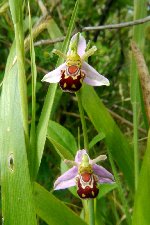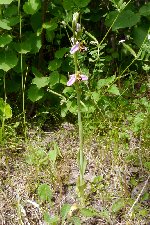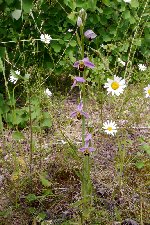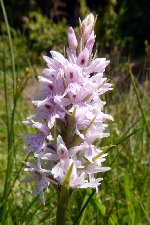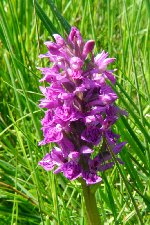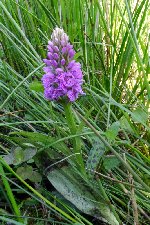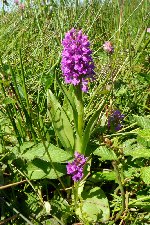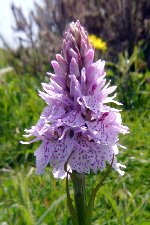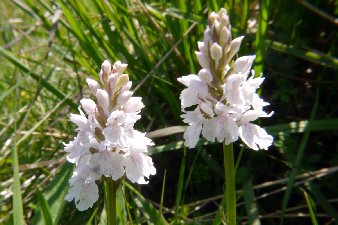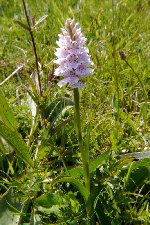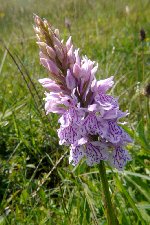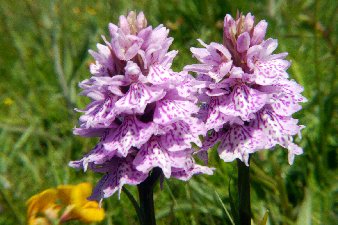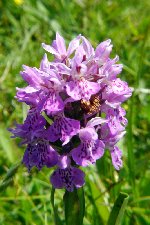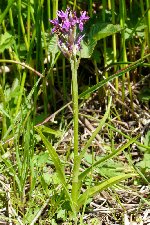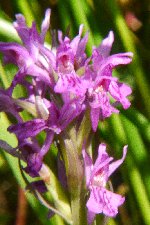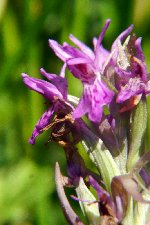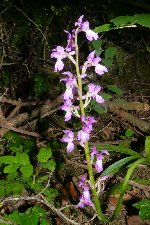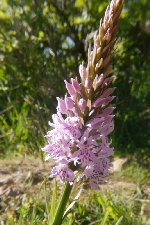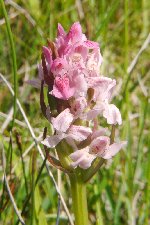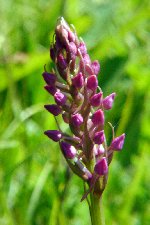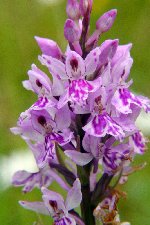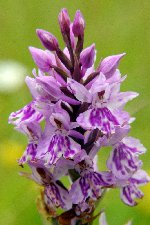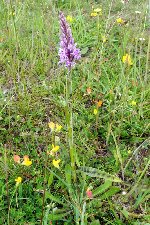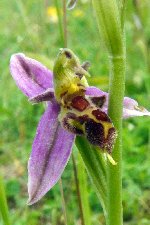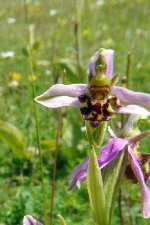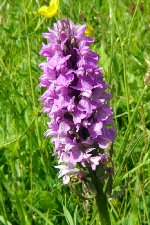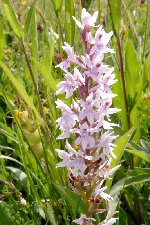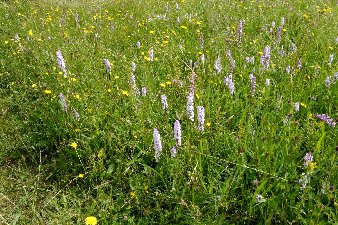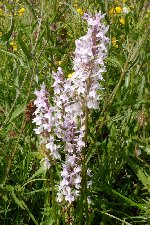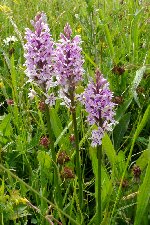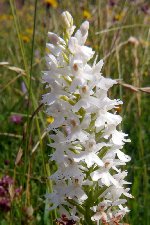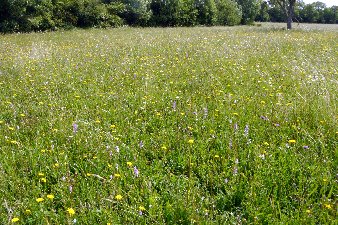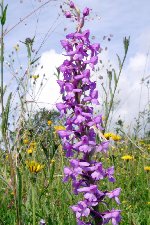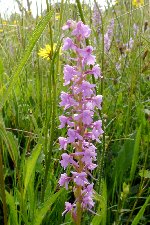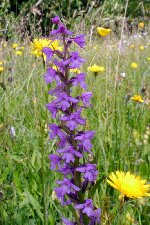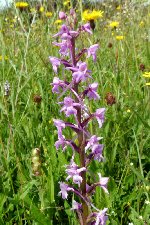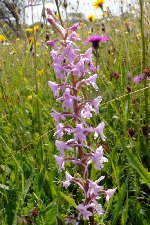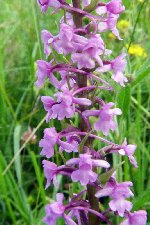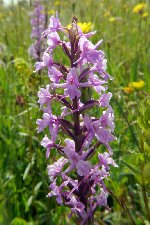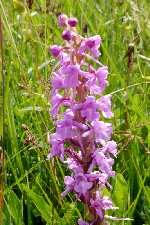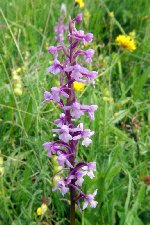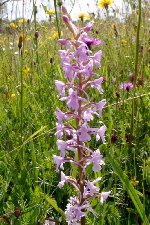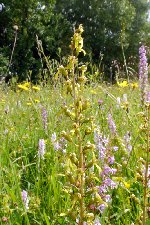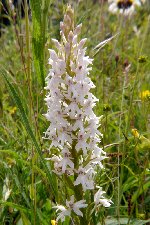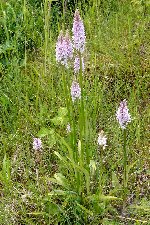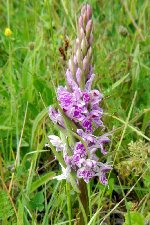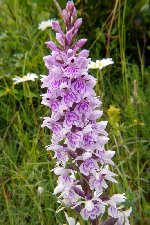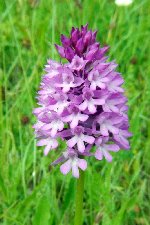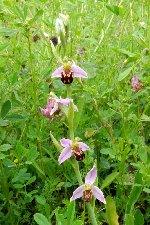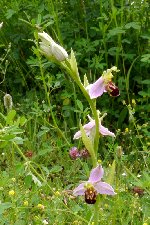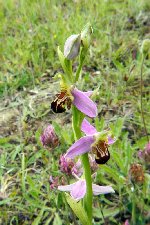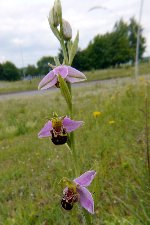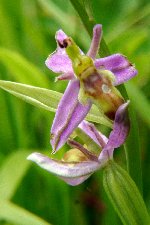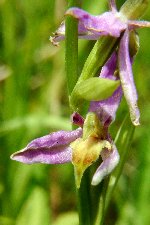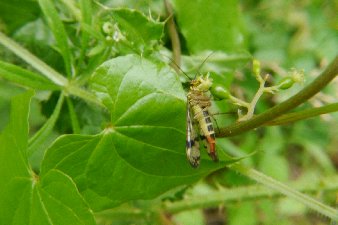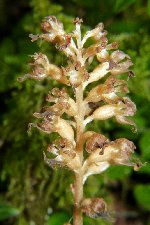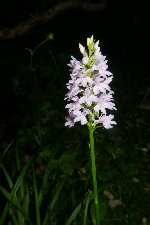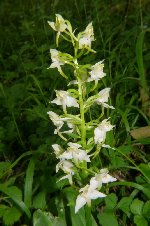|
|
|||||||||||||||||
|
|
|||||||||||||||||
 |
|
Conwy RSPB 11th June 2018 (SH 79527 77403) Just a visit to the carpark here, to have another look at the Bee Orchids we saw last year. They still look bigger and better than the ones inside the reserve, and exceed 30cm in height. I count 25 hiding in the margins and in the open. Now I look at them again I can see that they are remarkably consistent in patterning, with two or four small dots around the edge of the lip. Cors Erddreiniog 11th June 2018 (SH 45878 82152) Despite this being the largest fen on Anglesey we have not been here before. Will it equal or surpass Cors Bodeilio? Actually, it does but because it is somewhat different. The first part of the walk is marked with both Common Spotted Orchids and Northern Marsh, and of course the hybrids between the two. Then as we follow the rise in the path towards the woodland there are plenty of Heath Spotted Orchids, in an array of shapes and intensity of lip patterning; some quite light and others fairly bold. Naturally there are some plants that must be Heath Spotted X Common Spotted hybrids and others that are Heath Spotted x Northern Marsh hybrids - but not too many. This is possibly because the HSO is diploid and the other two tetraploid. Any seed formed is likely to be triploid and therefore sterile, so that no introgression with either parent is possible.
Not far from the bench (thoughtfully provided for the weary walker) there are some Narrow-leaved Marsh Orchids (I prefer this name to Pugsley's Marsh Orchid). There are not may, and not that easy to spot for they are definitely not an in-your-face species. Rather weak looking and smallish, but definitely this species. It is the Marsh Fritillary butterflies that have attracted a small number of other visitors today. Seeing these is a first for me and I am happy that they not only rest long enough for me to take some photos, but also to do so with wings outstretched. However this was tempered by not finding any Lesser Butterfly or Fly Orchids here. I know the latter are supposed to and suspect the other species does, but a return here will only occur when I have some more certain information. Cors Goch 11th June 2018 (SH 50472 81676) We visited here in early May last year and I hoped that a return slightly later in the year might reveal more orchids and reveal some missed at Cors Erddreiniog. Actually it is a bit hit and miss. Surprisingly there are still some Early Purple Orchids in shady areas near the entrance, not only recognisable, but also in full flower - very late. We also come across some incarnata forms of Early Marsh Orchid, but only a few, and of course some Common Spotted Orchids. Disappointingly there seems to be no Narrow-leaved Marsh within sight of the boardwalk, nor on the bits where you won't get wet feet straying off the path a bit. There are some Fragrant Orchids, but these are still in bud. They are too loose flowered for Marsh Fragrants and quite sweet smelling. Heath Frangrant Orchids possibly, bearing in mind the location. Alyn Waters Country Park, 14th June 2018 (SJ 32996 54981) Back in 2012 a Dactylorhiza fuchsia var. rhodochila was reportedly found here. As I have mentioned before, in subsequent years I have looked in the area where it was said to grow and found nothing. Was this a false report, mistaken position, misidentification, porkies, or was the plant a victim of theft? Now I have a report of a `rhodochila-like' plant or two here (thanks Jeff), in the area of the original. I find them! Normally the lines and marks on the lip of the Common spotted Orchid are well defined and crisp, but these are heavier, and look like they were smeared on. So these come somewhere on the spectrum between normal and full blown rhodochila with an (near) entire solid magenta lip. Just a possibility that these are progeny between the normal forms and that 2012 plant. The time lag is appropriate for the time between fertilisation and flowering. So perhaps the rhodochila genes are still in the population, and a full variant may still appear. As it seem a shame not to look at the nearby Bee Orchids while in the vicinity I take some quick photos. Is that a var belgarum? I've looked previously for Bee Orchid variants here and found nothing. A refreshing change. Granville Country Park, Telford, 14th June 2018 (SJ 71992 12434) As I am passing not far away and have a bit of time to spare I can see if I can spot the Southern Marsh Orchids and hybrids said to grow here. It turns out to be a larger area than I expected and I won't have time to do it justice. However I do find a few typical Southern Marsh Orchids (and I mean a few). The only comment to make is that rather oddly they grew in long grass towards the top of a slope, and not where I would expect the ground to be damper. It is the site of old lime and coal works, and some of the structures are still present. These can be excellent or fruitless for orchids in my experience.
Eade's Meadow 15th June 2018 (SO 98160 64770) Back here again, a bit later in the year and now it is absolutely full of Common Spotted Orchids. There must be 15,000+ growing here. If the species were wiped out elsewhere this meadow could soon repopulate! Nice to find a pure white flowered var. albiflora. However it is the Fragrant orchids that intrigue me here. They grow at the end of the field, where the path turns to the right. So no need to stray off path for the occasional one elsewhere! Only the Marsh Fragrant Orchid is said to grow here, but clearly the Common Fragrant does to. Personally, I think there are others that are hybrids between species here? They would be even harder to identify, but what do you think? Regardless, clearly colour is not a discriminant when it comes to Fragrant Orchid identification.
We spoke to another visitor who reckoned that Eade's Meadow is the best flower meadow in the country. With 225 plant species it may well be. In fact people seem to go to just view the spectacle, without our obsessive quest for orchids, just a love of flowers. Ettington 15th June 2018 (SP 26482 49309) Just outside this Warwickshire village the main road has been realigned, with wide and sloping verges. An orchid flora has moved in (or was in the top soil brought here), with Common spotted Orchids, Pyramidal Orchids, and Bee Orchids. Shipston on Stour 15th June 2018 My previous attempts to find a Wasp Orchid have all come to nought, so a spot-on GR and brief written instructions where to find this elusive orchid is too good a chance to miss. As it happens, we only see one of them lurking in long grass, but it is clearly Ophrys apifera var. trollii. But equally clearly, it looks different to what I expected. Posted on social media one comment points out that it has a var. bicolour look to it. Two variants in one? How unusual is that? Not only is that but the second flower on the stalk even more unusual. Snitterfield Bushes 15th June 2018 (SP 20027 60348) This is a woodland reserve on a former WWII RAF base, and the concrete paths of its former use can still be seen. It claims to be home to several orchid species, and not much of a detour from our journey back to Birmingham, so worth a look. First off are some pale and lank Common Spotted Orchids dotted in the woodland, then at The Glade there are a good few thousand of them! But these are not what we are after. Broad-leaved Helleborines grow here but are well off flowering, but we are informed where the Greater Butterfly Orchids grow, in a fenced area. Deer protection perhaps? We have seen a great number of little hoof prints along the trails in the woods. But these are not we have come looking for either. It is the Birds-nest Orchids that grow here, but each leaf littered clearing is checked and devoid of them. We cross the road to the smaller part of the reserve and still nothing. For one last chance, just as we leave I decide to check one last little bit of woodland and find a single Birds-nest. It is a rather attractive honey-coloured one as well. We were also told of Bee Orchids growing on the golf course adjoining the reserve, but that's too much of an area to do a random search. Apparently one growing on a fairway had a marker for the groundsman to notice so he could avoid mowing.
|
|
|
||||||||||||||||||||
